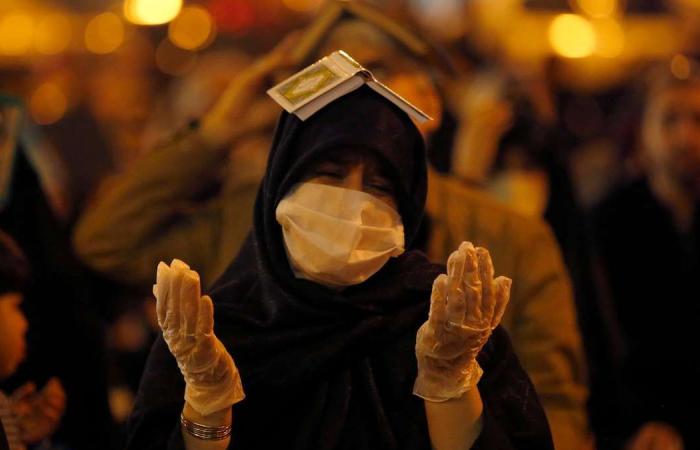Thank you for your reading and interest in the news Iran coronavirus cases surge again after lockdowns lifted and now with details
Hind Al Soulia - Riyadh - Coronavirus cases in Iran, until recently the hardest-hit nation in the Middle East, have spiked again as the country has eased restrictions.
The number of new daily cases in Iran peaked on March 30, with 3,186 and declined through April to a low of just 802 new cases on May 2. However, over the last two weeks, the number of new cases has steadily increased until it topped 2,000 again for the first time on May 15.
On Sunday, the country reported 1,806 new cases. Officials have downplayed the rise, saying that mortality continues to decrease even as cases pick up again.
However, health ministry officials have admitted the latest rises represent a setback, saying that clusters in some provinces had led to the spike in cases.
“We are in a situation similar to previous days [in most provinces] save for Khuzestan, which is still in a critical condition and it seems that North Khorasan may be critical as well,” health ministry spokesman Kianoush Jahanpour said last Thursday.
“If this trend continues, North Khorasan will require more serious measures, too,” he added in televised remarks.
North Khorasan province lies in north-east Iran on the border with Turkmenistan. Khuzestan province in the southwest borders Iraq.
Authorities in Khuzestan shut state bodies, banks and non-essential businesses again in around a third of its counties. Iran stopped publishing provincial figures for the coronavirus last month.
Authorities in the south-east province of Sistan and Baluchistan, which borders Pakistan and Afghanistan, have also warned of a fresh spike in infections.
“We had not seen such an increase in coronavirus infections since” late February, said Ghasem Miri, deputy head of provincial capital Zahedan’s medical university.
Mr Miri said the jump was due to the failure of people to observe “social distancing and health protocols.”
Since April 11, it has allowed the phased reopening of the country.
Iran has had 120,000 confirmed cases, just under 7,000 official deaths and 94,000 recoveries but a health report by Parliament last month said the true toll could be more than double the reported number. The document highlighted that only those who died in hospital were being counted in official tallies and said that the number killed by Covid-19 could be 80 per cent higher than the then tally of 4,777.
It also said that infections could be “eight to ten” higher than the then 76,389 infections.
For weeks, Iran tried to bring the numbers down without implementing a mandatory curfew or closing religious sites.
As cases soured and deaths mounted, authorities moved to close mosques and encourage people to stay home.
However, the Islamic Republic reopened religious sites earlier this month against the advice of health experts and crowds gathered at major pilgrimage spots.
In major cities, people have returned to work and are travelling more, even if facemasks are a more common sight on the streets of Tehran today than before the crisis.
The virus was first reported in Iran’s religious city of Qom and officials have repeatedly downplayed the virus – calling it a US conspiracy and blocking international aid groups from setting up dedicated field hospitals even as cases mounted.
Even as countries around the world mulled lockdowns and urged social distancing through February and March, Iran went ahead with the 41st anniversary of its 1979 revolution and legislative elections. Even weeks later as Nowruz approached at the end of March, officials did little to limit people from travelling or gathering.
The theocracy’s handling of the crisis – even as the virus has rippled through the offices of senior politicians – has led to rare public criticism of the government.
“The clergy’s apparent resistance to the state’s virus control mandates will likely be marked as a point of no return for public mistrust of clerics and suspicion about their ability to serve as rational authorities in the political or social sphere,” Mehdi Khalaji, a fellow at the Washington Institute for Near East Policy, recently wrote.
Meanwhile, the Islamic Revolutionary Guard Corps has stepped in to help the country handle the crisis in a bid to repair a tarnished image after admitting to shooting down a Ukrainian passenger plane killing all on board in January. The incident came amid the country’s response to the US killing of IRGC-Quds force head Qassim Suleimani on January 3.
Through the pandemic, the IRGC has set up clinics, carried out testing and deployed fighters for mass disinfection campaigns. – Additional reporting by agencies
Updated: May 17, 2020 06:10 PM
These were the details of the news Iran coronavirus cases surge again after lockdowns lifted for this day. We hope that we have succeeded by giving you the full details and information. To follow all our news, you can subscribe to the alerts system or to one of our different systems to provide you with all that is new.
It is also worth noting that the original news has been published and is available at The National and the editorial team at AlKhaleej Today has confirmed it and it has been modified, and it may have been completely transferred or quoted from it and you can read and follow this news from its main source.

